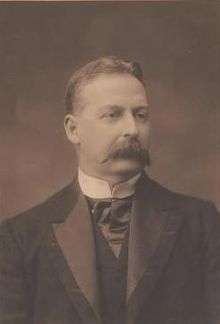Carty Salmon
| The Honourable Charles Carty Salmon | |
|---|---|
 | |
| Member of the Australian Parliament for Laanecoorie | |
|
In office 29 March 1901 – 23 April 1913 | |
| Preceded by | New seat |
| Succeeded by | Division abolished |
| Member of the Australian Parliament for Grampians | |
|
In office 20 February 1915 – 15 September 1917 | |
| Preceded by | Edward Jolley |
| Succeeded by | Edmund Jowett |
| 2nd Speaker of the Australian House of Representatives | |
|
In office 23 July 1909 – 30 June 1910 | |
| Preceded by | Frederick Holder |
| Succeeded by | Charles McDonald |
| Personal details | |
| Born |
27 July 1860 Amherst, Victoria |
| Died |
15 September 1917 (aged 57) South Yarra, Victoria |
| Nationality | Australian |
| Political party |
Protectionist (1901–09) Liberal (1909–17) Nationalist (1917) |
| Spouse(s) | Nancy Anne Harris |
| Alma mater | University of Melbourne |
| Profession | Doctor |
Charles Carty Salmon (27 July 1860 – 15 September 1917), generally known as Carty Salmon, was an Australian politician and Speaker of the House of Representatives.
Early life
Salmon was born at Amherst, Victoria on 27 July 1860 to English-born parents: storekeeper Frederick Browne Salmon and Susannah Carty, née Arnell. He attended Scotch College, Melbourne and, after a brief time with his uncle's tobacco company, returned to his father's grazing property. In 1886 he entered the University of Melbourne, studying medicine, obtaining Scottish qualifications and subsequently practicing as a doctor.
Politics
As honorary surgeon for the South Yarra Relief Committee, Salmon met Alfred Deakin and formed a lifelong friendship. He won an 1893 by-election for the Victorian Legislative Assembly seat of Talbot and Avoca as an independent, and became identified as a political liberal. He was a minister without portfolio, and subsequently minister for public instruction and commissioner for trade and customs, from 1899–1900 in Allan McLean's government. He married Nancy Anne Harris in Sydney on 3 October 1900.
In 1901, Salmon transferred to the Australian House of Representatives as the Protectionist member for Laanecoorie, holding the seat until its abolition in 1912. He became the House's second Speaker following the death of Sir Frederick Holder in 1909. He was known for his support of the White Australia policy, a strong national defence (not including conscription), and the policy of New Protection. In 1909, when the Protectionist Party amalgamated with the Anti-Socialists, he became a member of the resulting Commonwealth Liberal Party.
He attempted to transfer to the Senate in 1913 after his seat's abolition, but was defeated; he also declined preselection for the safe seat of Balaclava. In 1915, however, he won the seat of Grampians from Labor in a by-election and joined the Nationalist Party upon its formation in 1916.
Salmon was a freemason and from 1914 was the grand master of the Grand Lodge of Victoria. He was also a lieutenant-colonel in the Australian Medical Corps and commanded a base hospital in Melbourne in 1914. He died on 15 September 1917 at his home in South Yarra and was buried with Masonic rites and full military honours. His eulogy was delivered by Lowther Clarke, Archbishop of Melbourne, and both Prime Minister Billy Hughes and Leader of the Opposition Matthew Charlton attended his funeral.
References
- Hancock, I.R. (1988). "Salmon, Charles Carty (1860–1917)". Australian Dictionary of Biography. Canberra: Australian National University. Retrieved 2008-03-29.
| Parliament of Australia | ||
|---|---|---|
| Preceded by Frederick Holder |
Speaker of the Australian House of Representatives 1909–1910 |
Succeeded by Charles McDonald |
| Preceded by new seat |
Member for Laanecoorie 1901–1913 |
Succeeded by seat abolished |
| Preceded by Edward Jolley |
Member for Grampians 1915–1917 |
Succeeded by Edmund Jowett |